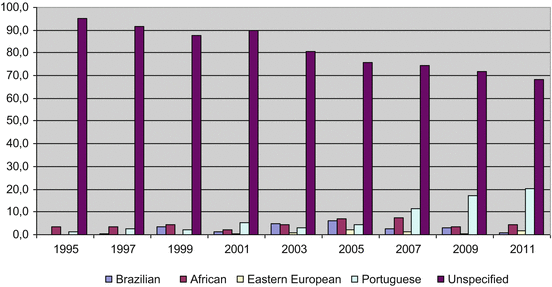Forced Sex, Chosen Sex: Risk, Trafficking, and Prostitution in Portugal

Fig. 9.1
Evolution in the number of massage and relax ads (1995–2011)

Fig. 9.2
Distribution of newspaper “massage and relax ads” by geographical origin of the women involved (%)
This evolution can be explained by several hypotheses, which can only be tested in future researches concerning female prostitution. Nevertheless, the first possible explanation pertains to an effective increase of Portuguese women in indoor prostitution, a situation that may have been pushed by the unemployment growth among the youth, leading to the emergence of “independent” indoor sex work as a new income source. A complementary element concerns the possible decrease of Brazilian prostitutes in the present context of crisis, following the return movement that is attaining Brazilian immigrants working in other activities. A second explanatory hypothesis is connected with the role of SEF inspections: foreign women don’t identify themselves to avoid being controlled, while Portuguese women do. Finally, a third possibility is associated with the adjustment to the changing demands of clients and also to an increasing value of Portuguese prostitutes, nowadays also in possession of the “Brazilian aesthetic-corporal skills”… Perhaps the sexy and exotic image connected to the novelty of the presence of Brazilian prostitutes in Portugal is losing power, and Portuguese women are presently more valued in the sex imaginary of Portuguese males.
Although the Brazilian women interviewed declared that the engagement in prostitution was an option and did not involve being trafficked to Portugal, constraint and risk are not absent from this process. On the one hand, limited references to “non-assumed” exploitation by pimps have been made, pointing to connections with the dangerous world of the nightlife. On the other hand, exposure to verbal and physical violence (by clients or pimps) was often mentioned, confirming the specific risk of prostitution when compared to other activities (Indoors 2010). High exposure to some health risks (HIV, gynaecological problems), although not present in the interviews conducted, is also a matter of concern, as demonstrated by the Indoors research. Finally, isolation and living conditions are also negative issues associated with the practice of indoor sex work “by choice” of the woman, this choice being highly constrained by the lack of available jobs adapted to low and mid qualifications, offering wages compatible with living standards above the poverty line or close to it. All things considered, shamefulness is a hallmark for several prostitutes that hide the activity from their relatives and friends, particularly in the country of origin. The wish to leave exists but is mitigated by the acknowledgement of limited work opportunities with wages comparable to those in prostitution.
Concluding Remarks
The analysis of prostitution through the lens of a risk approach, especially when assumed in a culturalist perspective that regards risk as a social construction that cannot be separated from the social and cultural processes that produced it (Douglas 1992; Kindler 2012), offers an interesting conceptual frame to develop a cross-comparative analysis of the two modalities (“classic” prostitution and trafficking for prostitution) discussed in the previous sections. The structure of Table 9.1 aims to operationalise this frame in terms of risk type and risk intensity, considering a set of dimensions that enable a comparison between the two forms of prostitution, which take place in the same society and are carried out by immigrants.